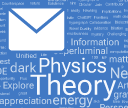Theories of the World
Several often arrive in a single day. Sometimes they’re marked “urgent”. Sometimes they’re long. Sometimes they’re short. Sometimes they’re humble. Sometimes they’re conspiratorial. And sometimes, these days, they’re written “in collaboration with” an AI. But there’s a common theme: they’re all emails that present some kind of fundamental theory invented by their authors (or perhaps their AI) about how our universe works.
At some level it’s encouraging to see how many people find it interesting to think about fundamental questions in science. But at some level it’s also to me very frustrating. All that effort being spent. And so much of it so wide of the mark. Most of the time it’s based on at best high-school physics—missing everything that was learned in twentieth-century physics. Sometimes it’s easy to tell that what’s being said just can’t be right; often things are too vague or tangled for one to be able to say much.
Most physicists term people who send such theories “crackpots”, and either discard their missives or send back derisive responses. I’ve never felt like that was the right thing to do. Somehow I’ve always felt as if there has to be a way to channel that interest and effort into something that would be constructive and fulfilling for all concerned. And maybe, just maybe, I now have at least one idea in that direction.
It doesn’t help the situation of course that there are so many myths floating around about how science makes progress. Newton suddenly figured out gravity when an apple fell on his head. Einstein was a lowly clerk when he figured out relativity. When one actually studies the history of science one finds that—essentially without exception—there’s always a long and sophisticated personal backstory to advances people make. Newton was already a top professor when the (perhaps apocryphal) apple fell. Einstein had got a PhD from a top university, and had then gone to the Silicon Valley of the time, the Swiss patent office.
It basically never happens that there are sudden flashes of insight that come out of nowhere. And that’s particularly true in fundamental physics, where a fairly tall tower of abstraction and formalism has developed, particularly over the past century or so. There’s everyday physics, of the kind we can reason about from our everyday experience. And then there’s physics of the very large and very small that’s far from our everyday experience. But it’s that physics that’s our best probe of the fundamentals of how things work. And if you don’t know it, you’re at a crippling disadvantage in making foundational progress in physics.
Of course, I would be the first to say that in science “conventional wisdom” often leads one astray. There need to be new, fresh ideas. And often ones that challenge the foundations of things that have long been assumed. But when—as in physics—there’s methodological depth to what’s been figured out, that’s a good place to start in making further progress. Maybe the traditional mathematical approach to quantum field theory isn’t quite right. But to discard all the abstractions and generalizations that got us to quantum field theory, and to return, for example, to high-school physics takes us to the wrong level of thinking.
What’s the story of my own efforts at figuring out fundamental physics? The past few years have been exciting times for me. Building on basically a lifetime of science and technology to arrive—to my great surprise—at what seems to be a serious breakthrough in understanding fundamental physics and how our universe works. And while what’s now our Wolfram Physics Project can at a superficial level be explained fairly simply, what’s underneath is quite a tower of ideas, formalism and computational investigations.
At some level, though, I’m an “amateur physicist”, doing science as a hobby—like the people who write to me. But under the surface, the story is rather different. Yes, for nearly four decades my main day job has been CEOing a tech company. But (as a mid teenager) I started out doing physics, and soon was a rather successful professional physicist. And indeed a key motivation for my efforts in technology has always been to build tools I want for myself for doing science. So, yes, over the years I’ve indeed maintained what one might call a “serious hobby” of doing science (now, for example, with the Wolfram Institute).
It has to be said that I’m pretty sure I wouldn’t have been able to do the things I’ve done if I’d stayed embedded in the academic system—with its increasingly strong toe-the-line constraints. It’s been crucial that I’ve been in a situation where I’m free to chart my own independent intellectual path. But despite that institutional independence I’m still routinely leveraging my rather extensive knowledge of existing physics. It’s true that the new paradigm I’ve built has led me to reject some of what has long been believed. But I’ve never rejected anything lightly. I always make a point of thoroughly understanding what I’m rejecting—and as part of that it’s become my practice to make a detailed study of its history, to see just how people originally came to believe it.
If you just catch something I say on a podcast you might get the idea that the things I’ve figured out just came to me in the simple way I describe them. But it’s not like that at all. It’s always a complicated process, full of detailed, systematic work. Central to the way I do things is the tower of technology we’ve built over the past four decades. I use Wolfram Language as a medium to clarify my thoughts. And I use it to make those thoughts concrete in computer experiments—which routinely produce results I absolutely did not expect. As much as possible, I insist on trying to understand everything from its first principles, so I can be confident that I know what I’m talking about. (Oh, and it also helps that I work with very talented people, and have a large network that includes many of the world’s leading scientists.)
So, yes, even if I manage to explain it simply, there’s always all sorts of sophistication behind the science I do. So when I get an email that says “I just figured out physics yesterday”, or “there’s this high-school physics fact that explains the universe” it profoundly doesn’t ring true. Even if someone says “an AI helped me” and there’s a veneer of technical academic presentation.
My 1975 Experience
In 1975—when I was 15 years old—I had just started writing papers about my own physics research when I received a curious letter, now preserved as a yellowing page in my archives:
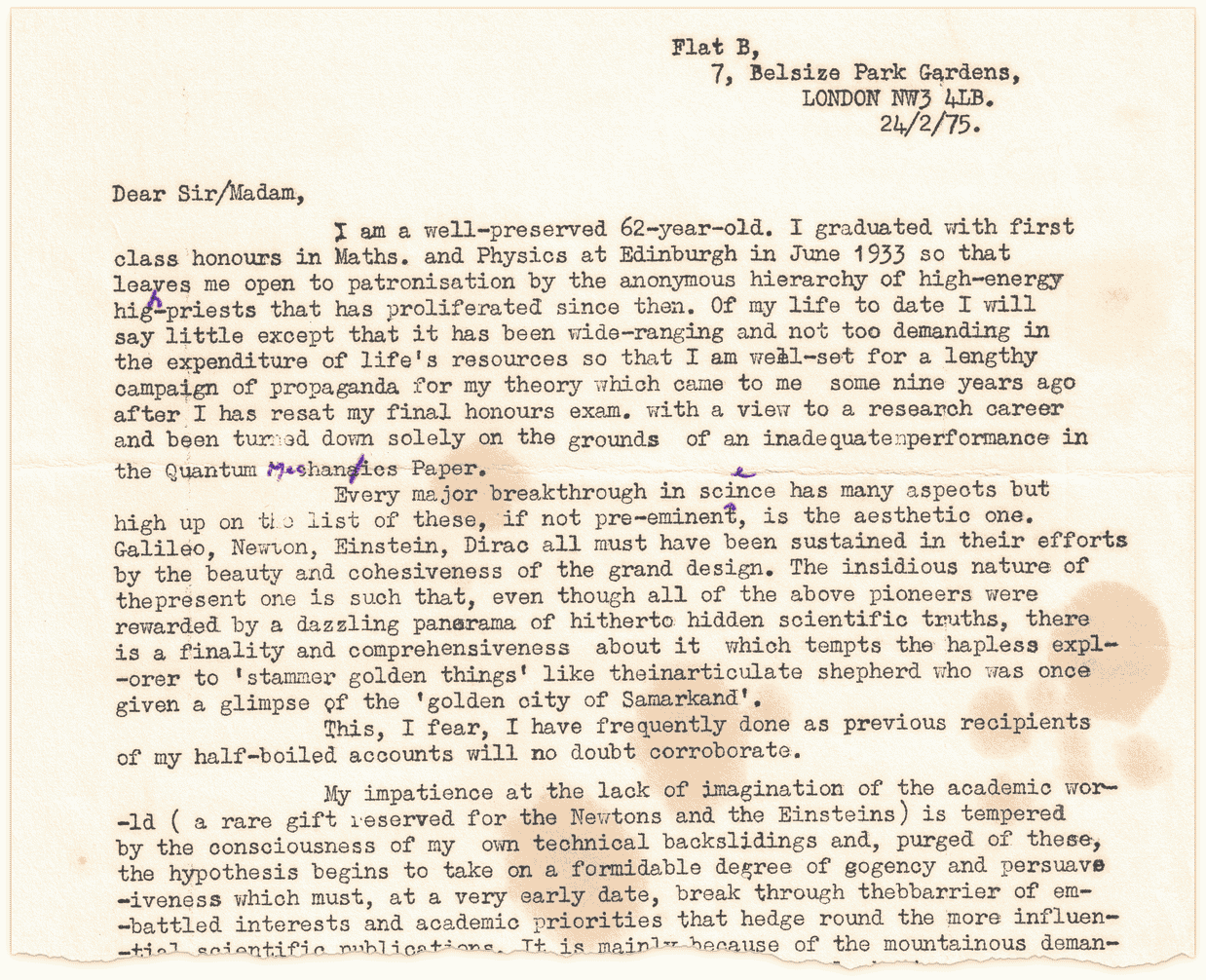
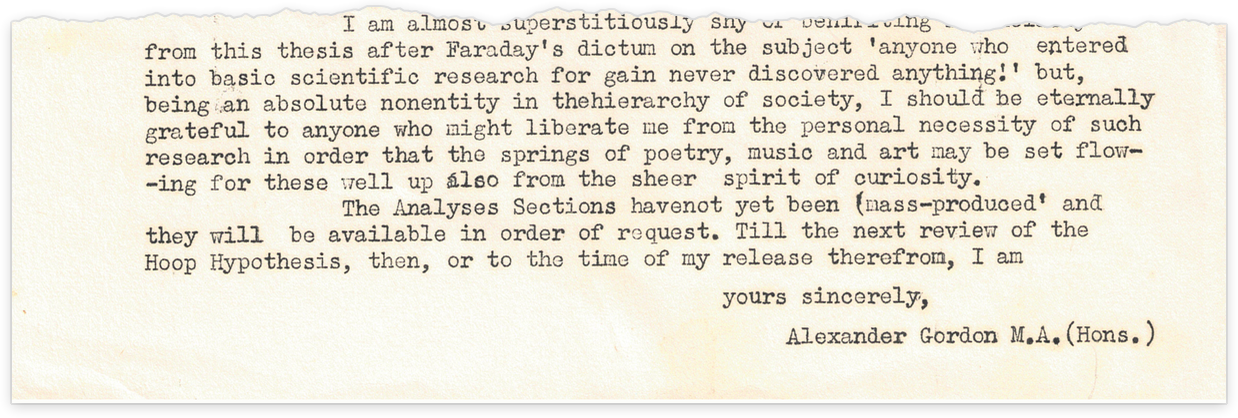
Its author went on to describe (at length) his “Hoop Hypothesis”—that particles like electrons and protons are in effect little loops of wire carrying electric current:
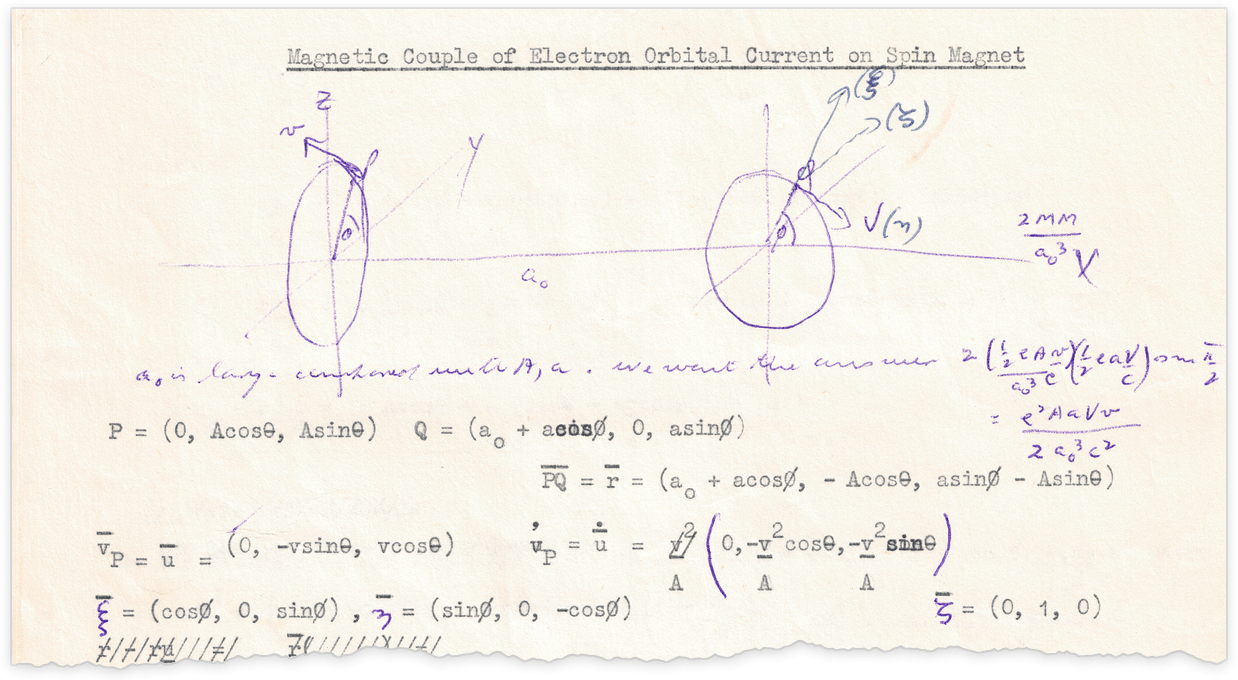
There seemed to be things that were obviously wrong, so I decided I’d point them out (Eton College was the high school I was at; the “New Buildings” were from the 1840s):

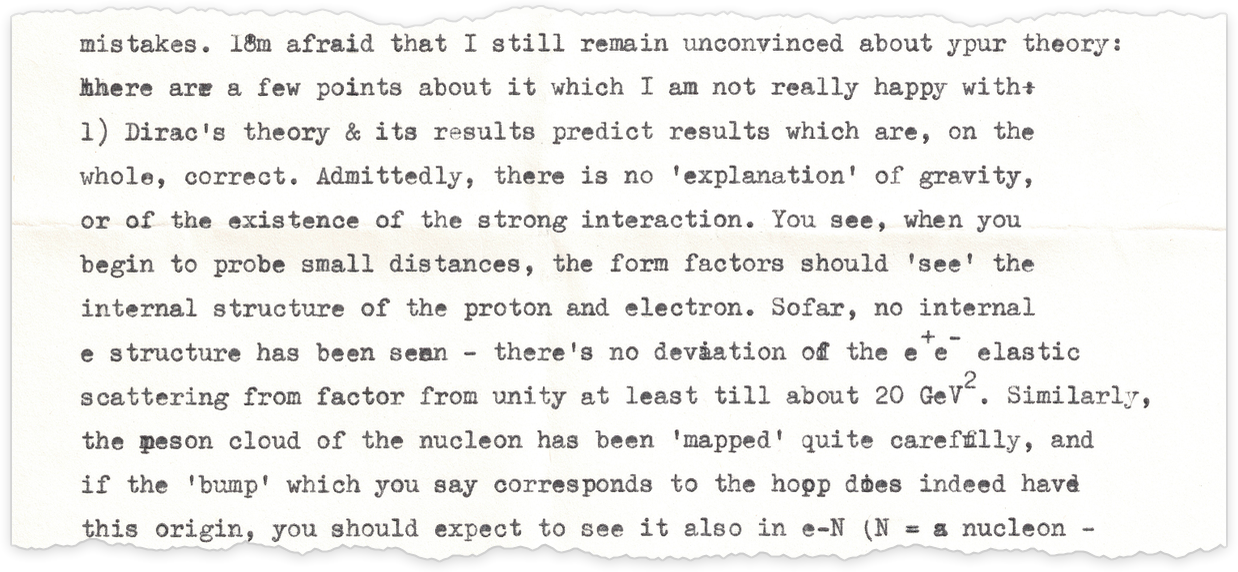

Yes, I was a lot younger then (with a duly immature signature!). And I didn’t anticipate that after my first response I’d receive a deluge of letters full of elaborate handwritten calculations. I responded a couple of times, but didn’t seem to be making any headway. And so I gave up. But then I started getting letters saying “please send back my calculations”. My archives still contain the envelope I’d prepared to do that. But I felt I should say something definitive to close things off. And I never got around to that. Which I feel a little bad about…
But looking at the letter I received half a century ago it’s striking how similar it is to so many of the emails I get today (though today the writing is not usually so eloquent). Somehow there’s an enthusiasm for “solving physics” using everyday thinking and everyday experience that’s persisted all that time, and about which people who haven’t been deeply exposed to twentieth-century physics develop surprisingly great conviction.
What Should People Actually Do?
Let’s say you’re passionately interested in doing science, but you haven’t had a chance to spend years learning the technical details of something like existing physics. What can you do?
Maybe you have some particular idea, perhaps based on something you’ve heard about or read about. If the idea is an area with as much technical depth as physics, it’s realistically going to be an immense challenge to develop the idea in a useful way. And most likely to really do so you’d have to learn a whole tower of technical details—the equivalent of several years of schooling.
But nowadays, you might think: “Can’t AI help?” Well, if you tell your idea to a high-end LLM it’ll probably be able to produce something about it that looks and feels like a scientific paper. But unfortunately with almost absolute certainty the paper will ultimately be complete nonsense. At a sentence-by-sentence or even paragraph-by-paragraph level it may seem OK. But—assuming your idea hasn’t already been worked out somewhere on the internet for the AI to read—then regardless of how much “reasoning” the AI claims it’s doing, it’s almost astronomically unlikely that it’ll produce anything that hangs together.
But while AI on its own isn’t realistically going to help, computers and computation potentially can. Because if you can get your idea “beyond pure words” to something more formal and precise, then it’s potentially a different story. Because then you may be able to do the kind of thing I’ve routinely done for so long, and use the power of computation to do the “heavy lifting” to explore your ideas. And, yes, it’s an ideal use case for the Wolfram Language. Because the Wolfram Language not only lets you describe things to a computer; it also helps you formulate your ideas in clear, computational form. And these days there’s even a good chance you’ll be able to use our AI Notebook Assistant to help you get started.
But the thing to emphasize is that if this is going to work, you’ll at some point have to actually understand—with clarity—the computational language code to describe your idea. It’s a high bar to reach if you start “just with words”. But if you reach it (or get someone to help you reach it) you’ll be off and running, able to do “real science”, relying on a computer and Wolfram Language just like so many of the world’s leading scientists do.
If I’m realistic, though, only a tiny fraction of the “avocational science” emails I receive seem even close to being amenable to this kind of formalization. And most of the time I just feel they picked the wrong battle. They’re trying to “solve physics” and “beat Einstein”. But, as I’ve explained, you have to have a lot of technical knowledge to even credibly get to the starting gate in such an effort.
So is that the end of the story? Are the front lines of science just closed to anyone who isn’t in the “priesthood” of highly trained scientists? Well, you’ve got to expect to do careful, systematic work. But the good news is that these days there’s a certain opportunity for great, foundational contributions to be made that don’t depend on all the technical details of, say, existing physics.
Yes, in these years, there’s a way for someone without all that technical training to do foundational science that’s significant and thoroughly original—and potentially has all sorts of philosophical as well as scientific significance. It won’t be something that “swoops in and solves physics”. But it can be a building block that might even apply to physics—and that represents a lasting intellectual contribution.
As it happens, it’s been my own work over the past 45 or so years that’s perhaps most clearly highlighted what’s possible. But ultimately what’s opened up the opportunity is that great intellectual development of our time: the computational paradigm. Unaided, there would be no alternative but to toil through all those technical details to reach frontiers of science. But what we’re learning is that thinking in fundamentally computational terms provides something transformative: a way to see directly deep into the foundations of science. And for those who choose to use it, a way to chart a direct path right to the frontiers.
In the past it wouldn’t have been so clear. But particularly now with our Physics Project and everything that’s followed from it, I think we can be confident that there are meaningful computational foundations to be found for theoretical science, “underneath”, for example, fields like physics and mathematics. And it’s these foundations that—with the help of computation—give us access to a new frontier of science.
It’s all about exploring the computational universe—the universe of computational possibilities. The computational universe is infinite. And there’s a place in it for everyone. A place that’s never been visited before. Where there’s new science to be found—that, once found, will stand forever.
These days I have a name for this type of science. I call it ruliology: the study of systems with (usually simple) computational rules. In some ways one can view ruliology as the ultimate theoretical science: the science from which other sciences must flow. I myself have been doing ruliology for 45 years now, and it’s been at the heart of most of the discoveries I’ve made over all those years. But in all that I’ve done I haven’t even begun to scratch the surface of what there is to discover in ruliology.
Pick even perhaps the single best-explored part of ruliology: the study of cellular automata. Going out into the computational universe one can instantly find examples full of all sorts of richness that one can be pretty sure nobody has ever seen before:

Each of these is like a world unto itself: a system with all sorts of detailed behavior that can be studied. It needs scientific creativity to figure out what to look at. And it needs a certain clarity of thinking to keep track of what one might find. But with Wolfram Language as a tool, there’s no limit to the explorations one can do.
Create a computational essay describing them, and you’ll have made a clear contribution to science. Don’t expect that the details of what you’ll see will immediately relate to phenomena, say, in physics. Even if you’re using hypergraphs, multiway systems, etc. you’re inevitably operating far below even what physics over the past century has explored. But the more broadly and deeply you investigate, the more you’ll have a chance to find core phenomena in ruliology that’ll flow through to lots of other places, including potentially physics.
By doing computer experiments you’ll develop a new kind of intuition. I don’t think I’ve ever seen someone who isn’t at first surprised by what they see out in the computational universe once they carefully look at it. But with that intuition you’ll get a sense of what you might explore in the computational universe. And you’ll get a real, “21st-century” way to think about science. Something that in the end might lead you not only to specific scientific conclusions but also much deeper and more general conceptual or philosophical conclusions.
Everyday experience of the world gives one a certain intuition, whose implications have been well worked through over the millennia. But experience of the computational universe is something new, and something from which—if one successfully internalizes it—one can derive fundamentally new thoughts about the way things work.
So what does this mean for the stream of emails I receive? Just sometimes there’s already a piece of ruliology. Where there’s a clear, computational phenomenon that the mail describes. And when I get such mail I think to myself “yes, there’s something that’ll be a surviving contribution to science”. But far too often the thrust of the mail is instead “here’s a theory I came up with by making an argument, largely with words”. Centuries ago that might have been par for the course. But now nothing like that has a serious chance of reaching the frontiers of something like physics.
And it could be that the only way to reach those frontiers would be to learn the whole tower of existing physics. But ruliology provides a unique shortcut. Ruliology is a field so vast, and so comparatively new, that in a sense we’re inevitably all at some level beginners in it. I’ve spent years building tools for it, that through Wolfram Language are now available to everyone. So now we’re all able to explore it together.
When one makes a discovery in ruliology, there’s a certain abstract permanence to it. That rule you found will always do that thing. It’s something that in a sense helps to elevate us beyond our mere human existence. We’ve come upon something that’s forever, that will always be that way. And it’s hard not to feel a sense of awe in being able to discover a thing like that, and to know that no human in history has ever seen it before.
I’d like to think that this kind of thing is the essence of what people seek when they try to come up with their “theories of physics”. But the difference is that a solid piece of ruliology—likely complete with striking and unexpected images—represents a real achievement in science that one can validly be proud of, and that can enter the long-term canon of science.
So, please, send ruliology, not yet more vague theories of physics! Let’s take all that energy and direct it to that foundational mission of 21st-century science: the systematic exploration of the computational universe.
How Do I Get Started?
The best way to start studying ruliology is to start doing it. Check out some of the things I have written about ruliology. Click any picture in any piece and you’ll get Wolfram Language to reproduce that picture. Start by finding a picture you think looks interesting. Try modifying its code, and try to understand what’s going on. We’re planning to put in place a systematic educational program for ruliology, as well as setting up a new, modern venue for publishing ruliological investigations. And we’re planning to provide infrastructure to help develop a systematic worldwide ruliological community.
Add yourself here to learn about developments with doing ruliology ›

